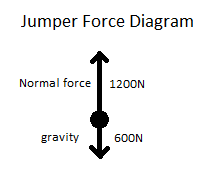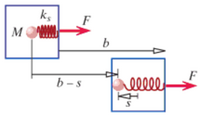Point Particle Systems
This page describes point particle systems and how they can be used to model certain aspects of a system's motion.
The Main Idea
A point particle system is a physical system, usually composed of multiple parts, modeled as though it were a single particle at its center of mass.
When work is done on a system, the energy imparted on it may take on multiple forms. These include Translational, Rotational and Vibrational Energy, Potential Energy, and Thermal Energy. Translational kinetic energy is kinetic energy due to the movement of the system's center of mass. All other types of energy the system has are considered "internal" types of energy because they do not affect the system's motion through its environment, but rather indicate its local properties. Sometimes, when work is done on a system, it imparts both translational kinetic energy and internal types of energy. For example, consider a ball rolling down a ramp. Gravity does work on the ball and increases its energy. It gains some translational kinetic energy (its center of mass gains a velocity down the ramp) and some rotational kinetic energy (its rolling motion causes it to rotate about its center of mass).
The purpose of modeling a system as a point particle system is to isolate the work done on it that raises its translational kinetic energy, which may only be a fraction of the total work done on the system. This is because point particles cannot have any internal types of energy. Modeling a system as a point particle system can make it much easier to calculate its motion through its environment, but offers no insights about the internal state of the system.
Point particle systems are in contrast to Real Systems (also known as extended systems), which analyze each part of a system individually instead of reducing it to a single point. Real systems can model a system's internal behavior in addition to its motion through its environment, although they can be very complicated and difficult to analyze quantitatively. Often, to obtain a complete model of a system's behavior, both point-particle and extended models are used.
A Mathematical Model
For a point particle system, the work-energy theorem is still true (see Work/Energy).
The work done on a point particle system is defined as
[math]\displaystyle{ W = \int \vec{F_{net}} \cdot d \vec{r} }[/math].
Let us assume that the net force acting on the particle is constant, so that we can get rid of the integral, and that the net force acts in the direction of the particle's motion, so that we can replace the dot product with regular multiplication. This will be the case for most point particle system problems. With these assumptions, the work done on a point particle is given by
[math]\displaystyle{ W = F_{net} d }[/math]
where [math]\displaystyle{ F_{net} }[/math] is the magnitude of the net force acting on the particle and [math]\displaystyle{ d }[/math] is the distance traveled by the particle.
The work-energy theorem states that work done on a system increases that system's energy. A point particle cannot experience an increase in internal energy. For example, the moment of inertia of a point particle about its center of mass is 0, so it can have no rotational kinetic energy. This means that all of the work done on a point particle system becomes translational kinetic energy.
In other words, for a point particle system,
[math]\displaystyle{ \Delta KE = F_{net} d }[/math]
and
[math]\displaystyle{ KE = \frac{1}{2} m v^2 }[/math].
The two equations above are the basis for answering questions using point particle systems.
Examples
1. (Simple)
A 60kg person jumps straight up in the air from a crouching position. From the time the person begins to push off of the ground to the time their feet leave the ground, their center of mass moves up 2m, and the normal force between the ground and the person's feet has a constant magnitude of twice the person's weight. Find the velocity of the jumper at the moment their feet leave the ground. Use 10m/s2 for g.
Solution:
Let us model the person as a point particle system. A force diagram for the person would look like this:
The net force acting on the person is the vector sum of the upward normal force and the downward gravitational force, which is a 600N force upwards. This force is constant and in the same direction as the person's motion, so multiplying it by the 2m displacement of the center of mass yields the work done on the person by their muscles:
[math]\displaystyle{ W = 600 * 2 = 1200 }[/math]Nm.
The person begins at rest, so their initial kinetic energy is 0J and their final energy is 1200J.
[math]\displaystyle{ \frac{1}{2} m v^2 = KE }[/math]
[math]\displaystyle{ \frac{1}{2} * 60 * v^2 = 1200 }[/math]
[math]\displaystyle{ v = \sqrt{40} }[/math]m/s.
In this problem, the system that was reduced to a single particle consisted of only one body, so treating the system like a point particle is not particularly innovative.
2. (Middling)
3. (Difficult)
Connectedness
- How is this topic connected to something that you are interested in?
I find the entire realm of physics fascinating, and I find it interesting how physicists are constantly coming up with new ways to solve problems and use formulas. The point particle system is a perfect example of that. It can turn a complicated force problem into something easy to approve. I also find it interesting how you can find other forms of energy, such as chemical energy, by using point particle and real systems. Something so small and seemingly unattainable can be found using this method.
- How is it connected to your major?
I am majoring in Materials Science and Engineering, and there are many ways all different types of physics can be used in MSE. The engineering of materials, specifically being able to calculate the amount and types of energy (and thus the cost) to produce something is absolutely crucial. Point particle systems can make this easier to do, while also adding precision to the calculations.
- An interesting industrial application
As seen in the above examples, there are many real life applications to point particle systems, such as the energy in a person falling, or in a yoyo. This system can also be applied to industry and manufacturing, with the use of various machines that may require gears, levers, or other objects that rotate. Using point particle and real systems, you can calculate the amount of internal energy happening in a moving machine, and therefore how much energy is lost.
See also
Further reading
For more help, a helpful page is: http://p3server.pa.msu.edu/coursewiki/doku.php?id=183_notes:pp_vs_real
A helpful video lecture: https://www.youtube.com/watch?v=T780lL5FlLg&index=41&list=PL9HgJKLOnKxedh-yIp7FDzUTwZeTeoR-Y
External links
See also Real Systems for further information on using Point Particle Systems to solve for the Real Systems.
References
Chabay, Ruth W., and Bruce A. Sherwood. "9." Matter & Interactions. N.p.: n.p., n.d. N. pag. Print.
Purdue Physics. https://www.physics.purdue.edu/webapps/index.php/course_document/index/phys172/1160/42/5399.
Yo-yo Clipart: https://www.clipartbest.com

